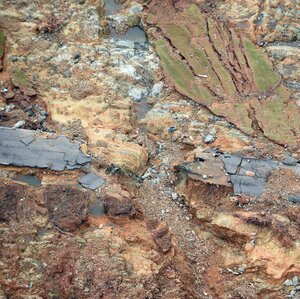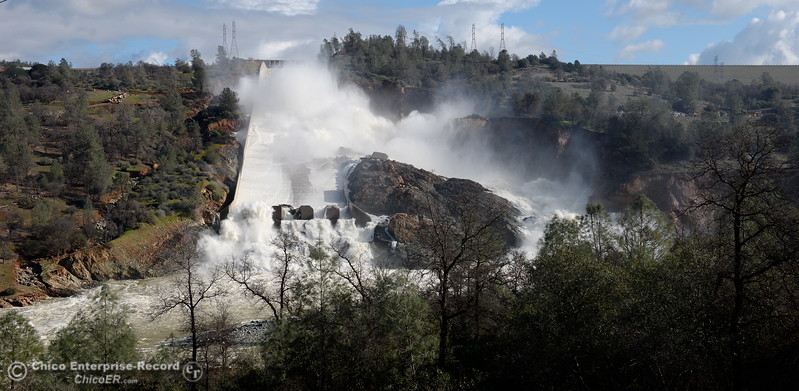Hamartia Antidote
ELITE MEMBER

- Joined
- Nov 17, 2013
- Messages
- 35,188
- Reaction score
- 30
- Country
- Location
http://www.npr.org/sections/thetwo-...officials-say-structure-can-withstand-next-st

The Oroville Dam's main spillway as seen on Feb. 14. Crews working round the clock since Sunday have made progress stabilizing this and another spillway damaged by water.
Marcio Jose Sanchez/AP
After two days of round-the-clock work to control water flowing over the Oroville Dam in Northern California, people who live downstream of the structure are allowed to return to their homes, officials announced Tuesday.
Nearly 200,000 people were affected by evacuations after water scoured enormous holes in two of the dam's concrete spillways beginning Sunday, raising concerns that the tallest dam in the country could fail.

THE TWO-WAY
With More Rain Forecast, Crews Work To Reinforce Oroville Dam
Butte County Sheriff Kory Honea announced Tuesday evening he was lifting an evacuation order issued on Sunday, Dan Brekke of member station KQED reported.
"Thousands of lives were protected [from] the looming prospect of a catastrophic failure of the emergency spillway," Honea told reporters, adding that residents should be ready to evacuate again if conditions change.
"There's the prospect that we can issue another evacuation order if circumstances change," he said.
The Red Cross said shelters remained open on Tuesday evening.
The Federal Emergency Management Agency also announced that federal disaster relief for Butte, Sutter and Yuba counties had been approved by the White House on Tuesday.
On Monday and Tuesday, crews dumped enormous rocks into damaged sections of the dam's damaged emergency spillway, hoping to prevent further erosion. The spillway is supposed to carry water from Lake Oroville around the main wall of the dam when the lake level is too high.
With the lake level still high and more rain forecast for later this week, officials rushed to prevent a catastrophe, as The Los Angeles Times reported:
"A swarm of trucks and helicopters dumped 1,200 tons of material per hour onto the eroded hillside that formed the dam's emergency spillway. One quarry worked around the clock to mine boulders as heavy as 6 tons. An army of workers mixed concrete slurry to help seal the rocks in place.
" 'This is an aggressive, proactive attack to address the erosion,' said Bill Croyle, acting director of the state Department of Water Resources. 'There's a lot of people, a lot of equipment, a lot of materials moving around, from the ground and from the air.'
"At the main spillway, a different and riskier operation was underway: Despite a large hole in the concrete chute, officials have been sending a massive amount of the swollen reservoir's water down the chute to the Feather River in a desperate attempt to reduce the lake's level.
"The structure continued to hold Tuesday without sustaining more significant damage, officials said."
drought in California, the National Weather Service said Tuesday that much of the state is on track for the wettest winter ever recorded, filling reservoirs and replenishing alpine snowpack that will continue to feed rivers for months.
View image on Twitter


The Oroville Dam's main spillway as seen on Feb. 14. Crews working round the clock since Sunday have made progress stabilizing this and another spillway damaged by water.
Marcio Jose Sanchez/AP
After two days of round-the-clock work to control water flowing over the Oroville Dam in Northern California, people who live downstream of the structure are allowed to return to their homes, officials announced Tuesday.
Nearly 200,000 people were affected by evacuations after water scoured enormous holes in two of the dam's concrete spillways beginning Sunday, raising concerns that the tallest dam in the country could fail.

THE TWO-WAY
With More Rain Forecast, Crews Work To Reinforce Oroville Dam
Butte County Sheriff Kory Honea announced Tuesday evening he was lifting an evacuation order issued on Sunday, Dan Brekke of member station KQED reported.
"Thousands of lives were protected [from] the looming prospect of a catastrophic failure of the emergency spillway," Honea told reporters, adding that residents should be ready to evacuate again if conditions change.
"There's the prospect that we can issue another evacuation order if circumstances change," he said.
The Red Cross said shelters remained open on Tuesday evening.
The Federal Emergency Management Agency also announced that federal disaster relief for Butte, Sutter and Yuba counties had been approved by the White House on Tuesday.
On Monday and Tuesday, crews dumped enormous rocks into damaged sections of the dam's damaged emergency spillway, hoping to prevent further erosion. The spillway is supposed to carry water from Lake Oroville around the main wall of the dam when the lake level is too high.
With the lake level still high and more rain forecast for later this week, officials rushed to prevent a catastrophe, as The Los Angeles Times reported:
"A swarm of trucks and helicopters dumped 1,200 tons of material per hour onto the eroded hillside that formed the dam's emergency spillway. One quarry worked around the clock to mine boulders as heavy as 6 tons. An army of workers mixed concrete slurry to help seal the rocks in place.
" 'This is an aggressive, proactive attack to address the erosion,' said Bill Croyle, acting director of the state Department of Water Resources. 'There's a lot of people, a lot of equipment, a lot of materials moving around, from the ground and from the air.'
"At the main spillway, a different and riskier operation was underway: Despite a large hole in the concrete chute, officials have been sending a massive amount of the swollen reservoir's water down the chute to the Feather River in a desperate attempt to reduce the lake's level.
"The structure continued to hold Tuesday without sustaining more significant damage, officials said."
drought in California, the National Weather Service said Tuesday that much of the state is on track for the wettest winter ever recorded, filling reservoirs and replenishing alpine snowpack that will continue to feed rivers for months.
View image on Twitter

Last edited:









